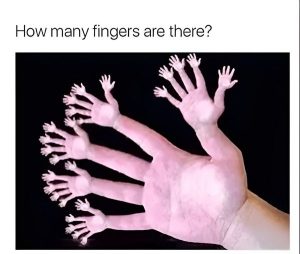Optical illusions have always fascinated people, offering a blend of art and psychology that challenges the way we perceive the world around us. One particular optical illusion has taken the internet by storm, leaving viewers puzzled and questioning their perception of reality. Originally shared on TikTok by the account @unseenillusions and later gaining traction on Reddit, this illusion asks a seemingly simple question: How many fingers can you see? However, as many have discovered, the answer isn’t as straightforward as it appears.
The Optical Illusion Explained
The image at the center of this viral sensation features a human hand against a stark black background. But there’s a twist – rather than showing just one hand, the image is a composite of several smaller hands, each connected in a way that creates a confusing web of fingers. The illusion is both captivating and frustrating, as counting the fingers becomes a surprisingly challenging task.
What makes this optical illusion particularly interesting is the variety of responses it has generated. Some viewers have confidently provided their answer, only to find others vehemently disagreeing. The illusion plays on our brain’s tendency to group objects and recognize patterns, even when those patterns are misleading.
The Internet’s Reaction
As with many viral illusions, this one has sparked a lively debate online. Social media platforms like TikTok and Reddit have seen users sharing their guesses, explanations, and frustrations. One of the most intriguing aspects of this debate is the wide range of answers people have come up with. Some users have reported seeing as few as ten fingers, while others have claimed to count over 150.
One Reddit user went as far as to meticulously calculate the number of fingers, arriving at an astonishing total of 155. This user provided a step-by-step breakdown of their process, considering every small hand and each finger-like appendage in the image. Others, however, have taken a more philosophical approach, questioning the very definition of a “finger.” Is a thumb considered a finger? Do we count all visible digits, or just those that resemble a standard finger?
The Psychology Behind the Illusion
Optical illusions like this one work by exploiting the brain’s shortcuts in processing visual information. Our brains are wired to quickly recognize familiar shapes and patterns, which is why we often see faces in inanimate objects or can read jumbled words with ease. In the case of this finger illusion, the brain’s tendency to group similar objects together causes the confusion.
When we look at the image, our brains try to make sense of the jumbled fingers by organizing them into a recognizable pattern. However, because the image is intentionally designed to be confusing, this leads to different interpretations, and thus, different counts of the fingers.
The Debate: What is a Finger?
A significant part of the online discussion revolves around the technicalities of what constitutes a finger. Some argue that thumbs should not be included in the count, as they are anatomically different from the other fingers. This debate has historical roots, as the classification of thumbs has long been a topic of discussion in both anatomy and common language.
In many cultures, it’s common to refer to a newborn as having “ten fingers and ten toes,” which includes the thumbs in the count. However, others argue that since the thumb has a different range of motion and structure, it should be considered separately. This debate over definitions adds another layer of complexity to an already perplexing illusion.
More Than Just a Fun Puzzle
While this optical illusion is certainly entertaining, it also serves as a reminder of the limitations of human perception. It highlights how easily our brains can be tricked and how much we rely on context and learned patterns to interpret the world around us. In everyday life, these shortcuts usually serve us well, but in the case of optical illusions, they can lead us astray.
Moreover, the widespread discussion around this illusion shows the power of social media in spreading and popularizing such content. What might have been a simple image shared among friends has now become a global phenomenon, with people from all walks of life joining in on the debate.
Conclusion: The Illusion’s Lasting Impact
So, how many fingers do you see in this optical illusion? The answer might depend on how you define a finger, how closely you examine the image, and even how your brain processes visual information. Whether you find the image frustrating or fascinating, there’s no denying that it has captured the imagination of many.
This optical illusion is more than just a fleeting trend; it’s a testament to the complex and sometimes flawed nature of human perception. As we continue to share and discuss these illusions, we learn more about ourselves and the way we see the world. So, take another look at the image, count those fingers again, and join the conversation – you might be surprised by what you discover.
